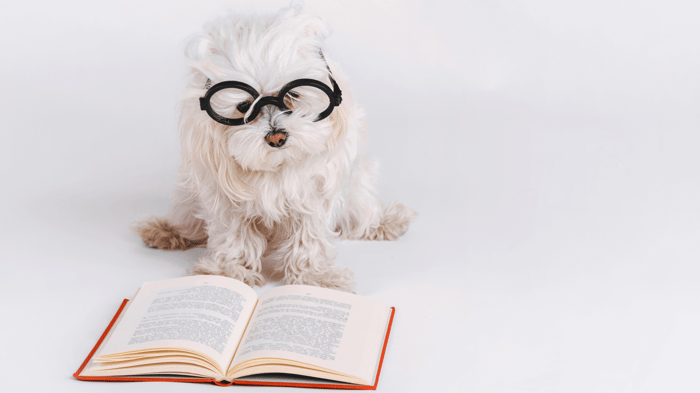Your tiny dog’s chewing the couch. Again. The barking starts the second you leave the room. She paces. He whines. And you’re sitting there thinking, What am I doing wrong?
Here’s the thing: nothing. You’re not raising a bad dog. You’re raising a bored one.
Toy breeds might come in small packages, but their minds are anything but small. These dogs are whip-smart, wildly curious, and wired for more than naps and snuggles. When that mental energy builds up with nowhere to go, it has to come out—usually in the form of nonstop barking, shadow-chasing, clingy panic, or a chewed-up slipper (or three).
Sound familiar? Yeah. You’re not alone.
Mental stimulation isn’t some bonus extra for little dogs. It’s survival. It keeps anxiety in check, builds confidence, and helps prevent the kind of mischief that makes your living room look like a toddler’s art project gone rogue.
And the best part? You don’t need a giant yard or fancy puzzle toys. You just need a plan. One that works in a studio apartment or a five-bedroom house. One that tires them out, lights them up, and fits into a normal day.
This guide’s got you covered—easy, low-cost brain games tailored for tiny dogs and the people who love them. Because your little dog deserves more than just belly rubs. They deserve to think.
Ready to turn boredom into brilliance? Let’s dive in.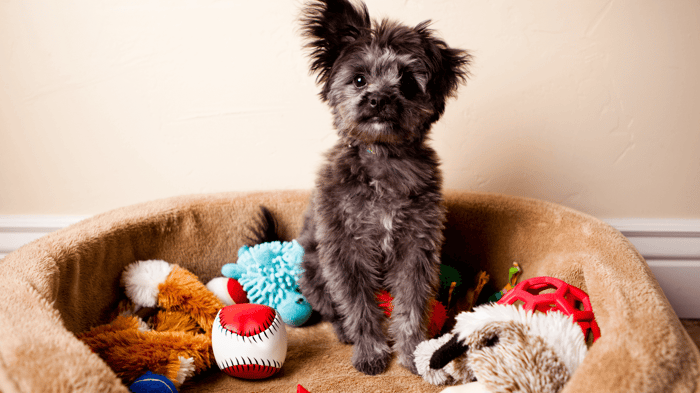 What Makes Toy Breeds Unique? Why Their Minds Need More Than a Walk
What Makes Toy Breeds Unique? Why Their Minds Need More Than a Walk
Ever watched a five-pound Pomeranian crack a food puzzle faster than you unlock your phone? That spark of curiosity is no accident—it’s centuries of selective breeding packed into a teacup frame, and it should make you proud.
Tiny dogs, turbo brains
- Bred to solve problems. From rat-hunting Yorkies to stage-strutting Papillons, many toy breeds earned their keep with quick thinking.
- Always on alert. Big eyes and satellite ears pick up every cue, including your mood shifts.
- Velcro loyalty. They study their humans like living textbooks, craving daily “assignments.”
A quick trot around the block drains their legs, sure—but their minds keep idling like sports-car engines. Give a chess grandmaster only checkers, and you’ll see the same restlessness.
When brainpower backfires
- Separation yelps balloon into anxious tantrums.
- Sofa zoomies carve NASCAR tracks in the carpet.
- Bark-loop reactivity has you Googling the “best small shock collar” or a “tiny training collar for small dogs.”
Spoiler: the collar isn’t the cure. Under-stimulation is. Without mental “reps,” even the sweetest lapdog can spiral into hyperactivity, reactivity, or clingy cling-foil behavior.
Mind workouts > mile counts
Physical exercise alone is like a single-gear bike on a mountain road; it can’t keep pace with a brain that evolved to chase, guard, or perform.
Consistent mental stimulation—nose-work scavenger hunts, trick-training bursts, micro-puzzles—flips the switch from chaotic to calm. You’ll spot the change in softer eyes, slower breathing, and that glorious post-game snooze.
Provide daily “brain snacks” and you transform restless genius into a relaxed companion. Up next: the exact games that turn tiny frustrations into big wins.
The Basics: What Is Mental Enrichment for Dogs (and Why Should You Care?)
Picture mental enrichment as Wi-Fi for your dog’s brain—silent, vital, and painfully obvious when the signal drops. Without it, small dogs glitch: endless bark loops, sofa sprints at midnight, shredded phone chargers. Restore that bandwidth and you unlock calm, focus, and the kind of naps you can set your watch by.
So, what exactly is it?
Mental enrichment is any activity that makes a dog think, sniff, decide, or solve—far beyond passively gnawing on a stuffed toy. Done right, it feeds core neurological needs the way protein feeds muscle.
Four fast flavors of enrichment:
- Scent Work – Hide kibble in a scrunched bath towel; every fold becomes a crime scene to investigate.
- Puzzle Play – Flip-top boards, sliding bricks, or a DIY muffin-tin maze push tiny paws to problem-solve.
- Micro-Training Bursts – Ten reps of “touch,” “spin,” or “find it” before breakfast sharpen focus and build vocabulary.
- Exploration Missions – Let your pup sniff new textures (gravel, grass, hardwood) or climb a pillow “mountain” indoors; novelty lights up neural circuits.
Why bother? Because enriched dogs bark less, nap longer, and walk into the vet with the confidence of a TED speaker. Anxiety melts, bonding grows, and that tiny training collar for small dogs becomes a gentle backup—not a go-to—because your dog is thinking first, not reacting.
Best of all, enrichment can be fun, fast, and free. A scent trail scrawled with kibble across a hallway rug takes sixty seconds to set up and burns more brain fuel than a mile-long walk.
Ready to plug your pup back into full power? Keep reading—the real games start next.
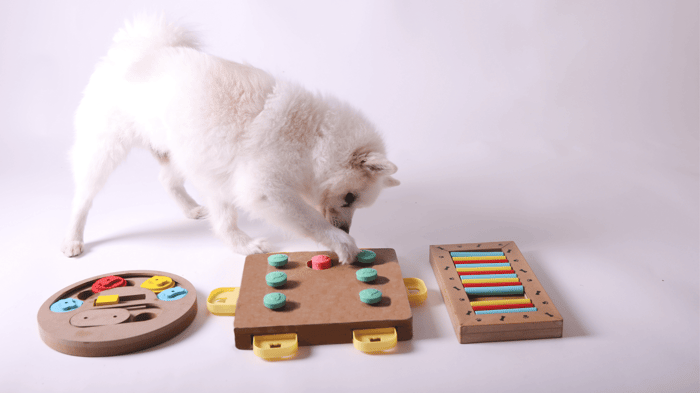
15 Brain Games Perfectly Sized for Tiny Dogs
A. DIY Games You Can Make Today
Muffin tins, bath towels, and red Solo cups turn into a canine escape room when you add a handful of kibble. Got a bored Chihuahua? Watch the gears spin.
- Muffin-Tin Treasure Hunt – Drop nuggets in the cups, cap them with tennis balls. Each flip feels like cracking a safe.
- Towel Burrito – Sprinkle treats down a bath towel, roll tight, twist like a taquito. Nose power required to unroll every inch.
- Old-School Hide-and-Seek – Duck behind a door or stash a squeaker in a laundry basket. Reward every find with a cheer.
- Shell Game – Three cups, one snack. Shuffle slowly, then faster. Your pup’s eyes track like a Vegas card shark.
- DIY Snuffle Strip – Cut fringe into a fleece scarf, scatter kibble through the fabric forest, let the sniffathon begin.
Why it works: scenting, problem-solving, and small-muscle paw work burn brain calories the way sprints burn carbs. And while you may use tools like the best small shock collar, these games help ensure it’s part of a well-rounded, thoughtful training plan—not a last resort.
B. Training Games That Build the Bond
You’re not just the treat dispenser—you’re the coach. Short, happy drills transform curiosity into confidence.
- Name-That-Toy – Hold up Mr. Hedgehog, say the name, reward every correct pick. Dogs hit a five-item vocabulary shockingly fast.
- Touch Target – Present your palm or a sticky note; mark when a nose bumps the spot. Great for redirecting nervous energy on walks.
- Confidence Tricks – Spin, back up, peek-a-boo through your legs. Each success rubs polish on tiny egos.
- Scent Match – Place cotton pads scented with vanilla, lavender, beef broth. Ask your pup to indicate the chosen smell—like a mini police dog minus the paperwork.
- Shape & Color Chase – Yes, dogs can learn blue versus yellow blocks. Start with two objects, jackpot the right choice, watch pattern recognition bloom.
Ten reps, two minutes, huge payoff. Mental reps tighten your bond—and when paired with a tiny training collar for small dogs, they create a clear, kind communication system that builds trust and brings out your dog’s best.
C. Store-Bought Toys Worth the Hype (Sized for Small Dogs)
Sometimes you want gear that’s ready out of the box. These picks respect fragile jaws and apartment acoustics.
- West Paw Toppl – Soft, rubbery, stuffable, won’t crack a Yorkie molar. Freeze yogurt inside for a twenty-minute puzzle pop.
- Nina Ottosson Puppy Puzzle – Sliding bricks reveal treats. Beginner level means victory comes quick and confidence soars.
- Snuffle Ball – A fleece pom-pom you load with kibble. Rolls, unfurls, reloads. Perfect for rainy-day fetch without furniture carnage.
- Pocket-Size Flirt Pole – Think cat teaser, but sturdier. Short bursts of chase satisfy predatory drive without marathon laps.
- Lick Mat – Smear peanut butter, goat milk yogurt, or low-sodium broth. Licking releases calming endorphins, the doggy version of guided meditation.
Why buy?
Durability, safety testing, and time savings. Rotate two toys per day, store the rest in a sealed bin so each reappearance feels brand-new. Combine purchased puzzles with DIY hacks and training drills, and you’ll have a tiny dog who naps like clockwork, barks less, and greets you with bright, eager eyes instead of pent-up jitters.
Mix, match, repeat—because simple games, served fresh, exhaust even the fastest little mind.
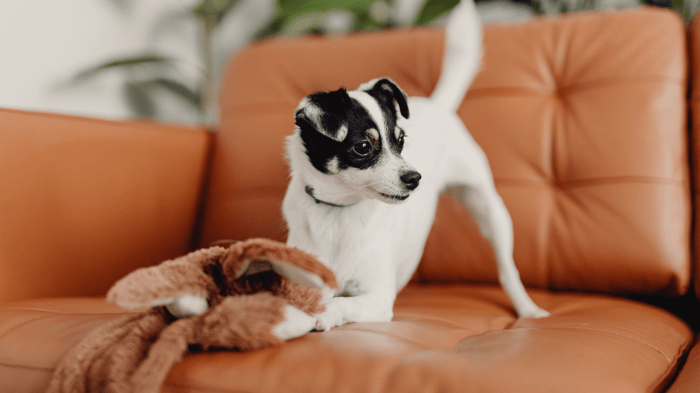
Daily Routines That Naturally Include Brain Work
Your calendar’s slammed, coffee’s cooling, and your tiny dog’s laser gaze says, “Entertain me.” Good news: brain work slides neatly into what you’re already doing—no extra hours, just smarter minutes.
- Meal-Time Missions – Trade the plain bowl for a stuffed Toppl or scatter kibble down a towel runway. Breakfast turns into a nose-driven treasure hunt that buys you a peaceful email sprint.
- Hallway Sniffari – Before you lace your shoes, flick three treats under chairs, two behind a door, one by the welcome mat. Sixty seconds of indoor tracking drains more mental juice than a ten-minute jaunt.
- Coffee-Break Cue Bursts – While the kettle sings, run five reps of “touch,” “spin,” or “find it.” Two minutes, zero sweat, huge dopamine hit for both of you.
- Toy-Rotation Tuesday (and Friday) – Box up half the toys, swap them twice a week. Predictability meets novelty; curiosity spikes at every unboxing.
- Evening Wind-Down Lick Mat – Smear goat yogurt on a mat, freeze for twenty minutes while dinner cooks. Licking releases calming hormones—the canine equivalent of slow jazz.
Dogs fed a steady diet of mini-challenges nap longer, bark less, and respond even better to tools like the best small shock collar—because their minds are already tuned in and ready to learn. Think of it as Netflix for neurons: constant content, easy to binge, cheap to produce.
Set a weekly calendar reminder titled “Brain Game Rotation.” Your future self will thank you, your couch will stay intact, and your pocket pup will snooze like a champion.
Relief? Check.
Confidence? Double check.
Red Flags: Signs Your Small Dog Needs More Mental Stimulation
Your tiny dog isn’t trying to drive you nuts. The barking, the pacing, the sudden obsession with digging up your bath mat—it’s not rebellion. It’s a brain screaming for work.
What gets written off as “bad behavior” is often boredom in disguise. Tools like the best small shock collar can be part of a thoughtful training plan—but they work best when paired with what your dog might truly be missing: challenge, novelty, and a reason to think.
Common signs of mental under-stimulation:
- Barking at every creak or passing car
- Circling, pacing, or repetitive motions
- Chewing on furniture, baseboards, or their own paws
- Superglue-style clinginess whenever you try to leave
- Overreactions to small triggers (doorbells, guests, dropped keys)
These aren’t quirks—they’re signals. Little dogs live in high alert by default. Without brainwork to help them focus and process, their nervous systems stay stuck in overdrive.
The fix isn’t “calm down.” It’s “engage more.”
Puzzles, training games, and even 2-minute trick drills can reroute all that reactive energy into purpose. And once their brains are busy, the barking fades, the chewing stops, and that tiny training collar for small dogs becomes a backup, not a Band-Aid.
Swap guilt for action. Your dog’s not broken—they’re just bored.
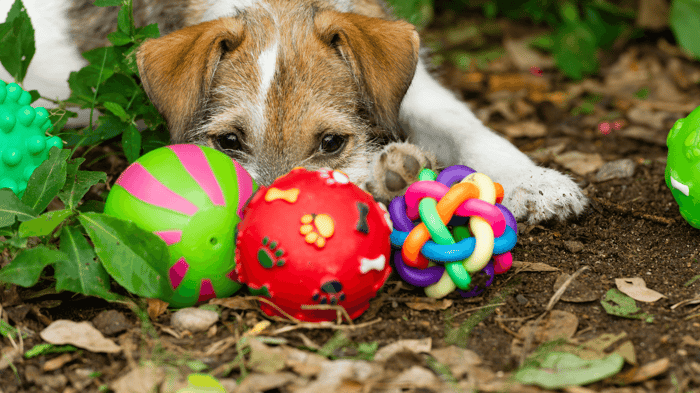
How Often Is Enough? Building a Balanced Mental Routine
Mental workouts don’t need to be marathons. For toy breeds, consistency trumps duration every time. Think short, purposeful bursts—like espresso shots for the brain.
Aim for 1–2 enrichment sessions a day, about 10–15 minutes each. That’s enough to take the edge off, spark curiosity, and cue the body to chill.
But every pup’s a little different.
- A high-strung terrier mix might need extra puzzles.
- A senior Chihuahua recovering from dental surgery? Slower sniff-based games will do.
- New rescue? Start gentle and build as trust grows.
Build your mental routine like this:
- Morning scent game or puzzle before you leave
- Evening trick training or licking mat wind-down
Routine matters. It gives structure, predictability, and something joyful to look forward to. Even just knowing a game is coming can calm a busy mind.
Remember: quality beats quantity. The goal isn’t exhaustion—it’s engagement.
Closing Inspiration: A Sharper, Happier, Calmer Little Companion
Remember that frantic, couch-chewing whirlwind we met at the top of this guide?
Picture that same pup now, head buried in a snuffle ball, tail swishing in quiet satisfaction.
That’s the power of brain work: it flips chaos into calm and gives your little genius a job worth doing.
You’re not spoiling a lapdog; you’re sculpting a sharper partner. Each puzzle, towel burrito, or two-minute trick session rewires pathways that once screamed boredom into circuits that hum with purpose. Studies keep circling back to the same finding: mentally enriched dogs live longer, enjoy steadier heart rates, and forge tighter bonds with their people.
So here’s your next step. Scroll back, grab any two or three games that made your eyebrows lift, and pencil them into this week’s routine. Monday Toppl, Wednesday hide-and-seek, Saturday shape quest—easy.
Track the change: fewer yap storms, longer naps, softer eyes following you around the kitchen.
Does it take effort? Sure. But the minutes you invest today pay you back tomorrow in serenity, laughter, and furniture that stays intact.
Most of all, you’re handing your pint-sized companion a life rich in curiosity, confidence, and joy—and that’s a reward few things else can match.

